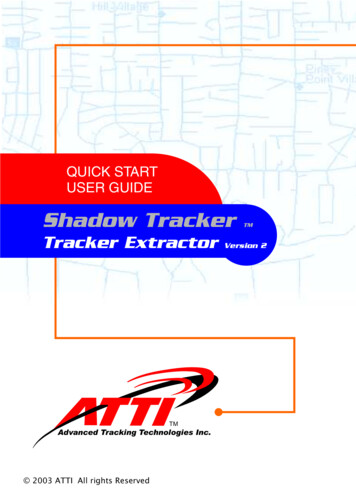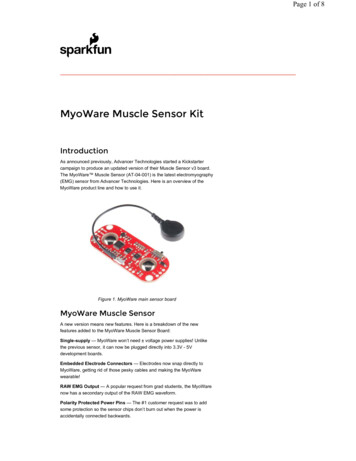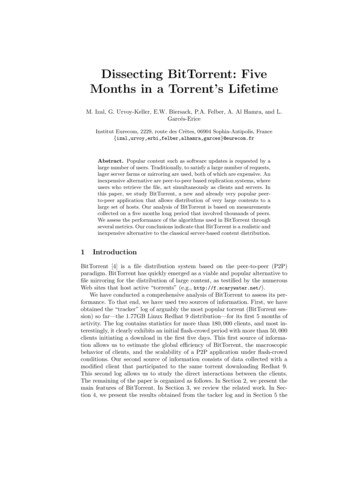Transcription
ORTHMAN MANUFACTURINGINCORPORATEDorthmanag.comTRACKER FEEDBACKSENSOR UPDATE KITOPERATOR’S MANUALSTILL THE STRONGEST125-018
Farm SafetyContrary to the popular image of fresh air and peaceful surroundings, a farm isnot a hazard-free work setting. Every year, thousands of farm workers are injuredand hundreds more die in farming accidents. According to the National SafetyCouncil, agriculture is the most hazardous industry in the nation.How You Can Improve Farm SafetyYou can start by increasing your awareness of farming hazards and making a conscious effort to prepare for emergencysituations including fires, vehicle accidents, electrical shocks from equipment and wires, and chemical exposures. Beespecially alert to hazards that may affect children and the elderly. Minimize hazards by carefully selecting the productsyou buy to ensure that you provide good tools and equipment. Always use seat belts when operating tractors, andestablish and maintain good housekeeping practices. Here are some other steps you can take to reduce illnesses andinjuries on the farm: Read and follow instructions in equipment operator’s manuals and on product labels. Inspect equipment routinely for problems that may cause accidents. Discuss safety hazards and emergency procedures with your workers. Install approved rollover protective structures, protective enclosures, or protective frames on tractors. Make sure that guards on farm equipment are replaced after maintenance. Review and follow instructions in material safety data sheets (MSDSs) and on labels that come with chemical productsand communicate information on these hazards to your workers.Health and Safety Hazards on FarmsFarm workers including farm families and migrant workers are exposed to hazards such as the icityPotential Effect or InjurySkin and respiratory injury or deathIllness, Frostbite or deathRespiratory injury or explosive combinationsShock, burns, fire, deathGrain bins, SilosEntrapment, Suffocation, Explosion fromformation of dangerous gases and poisoning.Injury including cuts abrasions, electrocution,strains, sprains and deathCollisions resulting in injury or deathHand toolsHighway trafficLifting and liftingdevicesLivestock handlingMachinery/EquipmentManure pitsMudNoisePondsSlips/Trips/FallsSun/HeatToxic gasesTractorsBack injury, sprains, strains. Falling materialresulting in being struck or crushed by heavymaterialSerious injury or death resulting from beingpinned struck or trampled.Cuts, abrasions, amputations, death.Explosion from formation of dangerous gases.Suffocation. PoisoningSprains, strains, entrapment and suffocation.Eye injury and skin irritation.Hearing damageDrowningSprains, strains, back and neck injury, bonebreaks or deathSun burn, Heat Stroke, shock, deathSkin and respiratory injury or death.Explosion.Cuts, abrasions, amputations, death.PreventionMSDS and proper Personal Protective Equipment. Review Manufacturers data sheetsDress properly for the day.Be aware of your surroundings and activityUse a qualified professional for wiring dangerous electrical devices. Never overload acircuit. Replace damaged electrical devices or cords. Electrical tape will not insulate youfrom injury.Make sure the bin is properly ventilated and maintained. Never walk the grain.Make sure you hand tools are in good condition. Never leave a damaged toolingaccessible for someone else to use.Follow regulations, stay alert. Avoid alcohol and use of communication devices whiledrivingUse proper lifting technique. Get help when the load is too heavy. Inspect chains, strapsor cables routinely to make sure they are in good condition.Always make sure you have adequate room and an escape routeThoroughly read and understand your Owners Equipment Manual. Never operate theequipment without guards in place. Make sure the equipment can not be energized orotherwise put into operation while you are working on it.Proper maintenance.Proper Personal Protective Equipment. In some conditions a “Spotter” may be needed.Personal Protective Equipment.Wear a life preserver and make sure help is readily available.Keep work area free from clutter and organized. If working on anything elevated makesure you have appropriate guarding and/or fall protection such as a harness and lanyard.Use common sense on excessively hot days, use sun screen, wear a hat and stay hydrated.MSDS and proper Personal Protective Equipment. Review Manufacturers data sheetsThoroughly read and understand your Owners Equipment Manual. Never operate theequipment without guards in place. Anti-roll over devices.WellsElectrocution, amputation, deathAvoid contact with water while working on an electrical device. Always be sure theequipment can/will not be energized during repair or maintenance. Make sure all guardingis in place.Severe WeatherElectrocution, “struck by” injuries, deathMove to a safe place. Lightening, hail and tornadoes are unpredictable.Orthman Manufacturing, Inc. does not limit the potential effects or injuries nor prevention measures to those listed above. They are provided solely as aguideline to making your farm life safer. Always consult your Owner/Operators Manual for specific tool and equipment safety requirements.
High Risk Factors on FarmsThe following factors may increase risk of injury or illness for farm workers: Age – Injury rates are highest among children age 15 and under and adults over 65. Equipment and Machinery – Most farm accidents and fatalities involve machinery. Proper machine guarding and doingequipment maintenance according to manufacturers’ recommendations can help prevent accidents. Protective Equipment – Using protective equipment, such as seat belts on tractors, and personal protective equipment(such as safety gloves, coveralls, boots, hats, aprons, goggles, face shields) could significantly reduce farming injuries. Take precautions to prevent entrapment and suffocation caused by unstable surfaces of grain storage bins, silos, orhoppers. Never “walk the grain.” Be aware that methane gas, carbon dioxide, ammonia, and hydrogen sulfide can form in unventilated grain silos andmanure pits and can suffocate or poison workers or explode. Take advantage of safety equipment, such as bypass starter covers, power take-off master shields, and slow-movingvehicle emblems. Medical Care – Hospitals and emergency medical care are typically not readily accessible in rural areas near farms.The Benefits of Improved Safety and Health PracticesOrthman Manufacturing Provides this document in the hope that everyone that has a job to do, does it SAFELY. Our goaland yours should be to end each day in the best possible health. Better safety and health practices reduce fatalities,injuries, and illnesses as well as associated costs such as workers’ compensation insurance premiums, lost production,and medical expenses. A safer and more healthful workplace improves morale and productivity.
Tracker Feedback Sensor Update KitOver time, some Orthman Trackers have began to experience a degraded performance due to corrosionrelated issues. The sensor is protected physically from impacts and dirt inside a metal housing. However,this metal housing is susceptible to corrosion from condensation build up. This kit is intended to replace thedegraded parts and to help prevent future problems from corrosion. Please follow the steps below to helpkeep your Orthman Tracker in good working order.
Tracker Feedback Sensor Update KitTo disassemble the feedback sensor assembly follow these steps1 Remove the sensor spindle cap assembly(A) OMI#333-6562 Remove 2X Round Head Machine Screwas shown. (A) OMI#106-059 3AABRemove Rotary position sensor asshown. DO NOT DISPOSE, this will beused when reassembling the sensorcomponents. (B) OMI#154-649 Remove 1X Round Head Machine Screw asshown. (A) OMI#106-141 Remove the large 2 1/4 snap ring asshown. (B) OMI#104-113AB
Tracker Feedback Sensor Update KitFeedback Sensor disassembly continued 45 Note the rotational position of the sensorplate, as this will be important to thereassembly process. With the large snap ring removed thesensor mount plate can be removed.(A) OMI#350-066 With the sensor plate removed (A), youmay now remove the O-Ring as shown.(B) OMI#150-081 Remove the set screw as shown.(A) OMI#106-177ABA6 Using WD-40, thoroughly spray down theinside of the sensor housing.Now, using a clean cloth wipe down theinside of the components to finish thecleaning process. Repeat these steps asnecessary to clean up any leftover dirt orcorrosion.A
Tracker Feedback Sensor Update KitWith the Sensor housing disassembled, clean and dry you may now begin to reassemble the sensor buildthru with the new parts included in your update kit. Make sure to apply the supplied Loctite222MSincluded in this kit, as it is crucial to the proper functioning of this assembly.123 Install the set screw as shown,applying Loctite222MS to thethreads as directed by theinstructionsonthebottle.(A) OMI#106-177AInstall new O-Ring in the lower channelas shown in the cutaway view.(A) OMI#150-081Reinstall the sensor mountplate in same position as theearlier removed sensor mountplate. (A) OMI#350-066With the sensor plate installed(A), you may now install thesnapringasshown.(B) OMI#104-113ABBAA
Tracker Feedback Sensor Update Kit4 Re-install Rotary position sensor asshown. (A) OMI#154-649 Before installing (B) Round Head MachineScrew , apply Loctite to the threads.(B) OMI#106-059 Once Loctite has been applied to theRound Head Machine Screws install (A)to the sensor mount plate (C) with (B).BAC5 Before installing (A) Round HeadMachine Screw , apply Loctite to thethreads. (A) OMI#106-141 Once Loctite has been applied to theRound Head Machine Screws install (A)to the sensor mount plate.A
Tracker Feedback Sensor Update KitTracker Feedback Sensor Update Kit ComponentsITEM NO.12345678QTY.21111111PART 81152-997DescriptionRound Head Machine Screw 8-3x1 1/4 Slotted DriveSensor 45 Degree Rotary PositionRound Head Machine Screw 6-32x 3/8"Slotted DriveRing Spiral 2 1/4 BoreSet Screw 1/4 - 28 x 1/4Sensor Mounting PlateO-Ring #035 SAE 120R1 Class 110ml Bottle Loctite222MS
Tracker Feedback Sensor Update Kit Tracker Feedback Sensor Up date Kit Components . ITEM NO. QTY. PART NO. Description 1 2 106-059 Round Head Machine Screw 8-3x1 1/4 Slotted Drive 2 1 154-649 Sensor 45 Degree Rotary Position 3 1 106-141 Round Head Machine Screw 6-32x 3/8"Slotted Drive 4 1 104-113 Ring Spiral 2 1/4 Bore .






